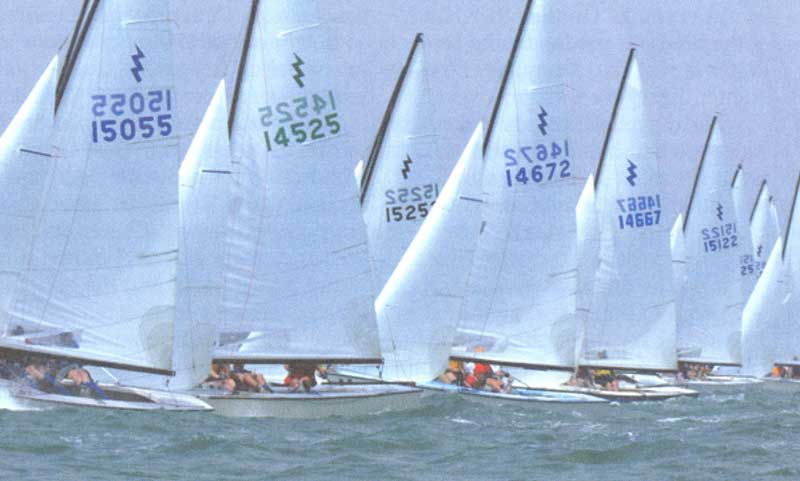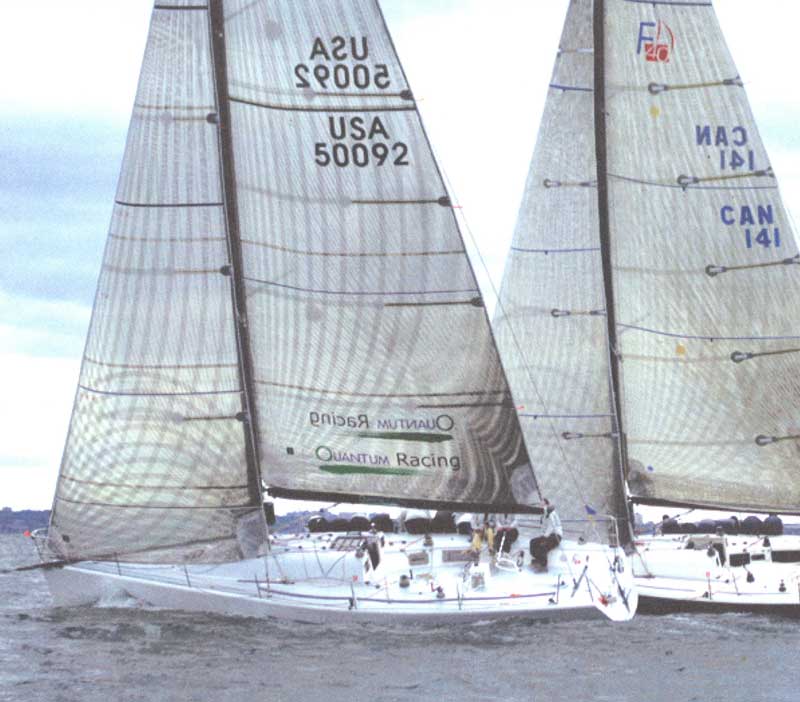|
Wally Cross on Tuning Your Rig
by David Dellenbaugh
If you want to go fast upwind,
one of the first things you need to do is make
sure that your rig is tuned properly for the wind
and wave conditions. Wally cross, a long-time sail
designer and mainsail trimmer, shares his approach
on how to set your mast for closehauled speed.
DAVID: Wally, what are your priorities for rig
tuning when you race on a boat for the first time?
WALLY: If the boat is a one-design I always try to
do some homework prior to the first sail. I
research which sailmaker is having success in the
class and read over their tuning guide for clues
about the boat. I view tuning guides as a good
starting point but not necessarily the final word.
Most of them are a bit dated, but they do
eliminate the need for a lot of experimentation.
 |
| Wally Cross has been a sailmaker since
1973 and enjoys sailing in owner-driver
classes. His race credits include three wins
in the Canada’s Cup and many successes in
one-design, inshore and offshore events.
Wally’s passion is helping boats sail faster
through rig and sail settings. |
My first tuning goal is making sure there is
symmetry in the rig, tracks, spreaders and so on.
IT is really important that the main and jib
(genoa) set up the same on each tack. Once I am
convinced both tacks are similar, I mark jib
tracks, halyards, backstay, jib sheets and inhaul
for future reference.
For every boat, it’s important to develop a tuning
sheet that gives the trimmers adjustments for
light, medium and strong winds. This guide should
have setting numbers for the jib halyards, jib
sheet, lead position, main traveler, backstay, and
vang in all three wind ranges. Having a resource
like this takes some of the mystery out of setting
the rig and sails. However, the tuning process
constantly changes, so you need to update it
continually with real race data.
Is it important to get your mast straight in
the boat? If so, how do you achieve this goal?
When I view a mast for the first time I check to
make sure it is set up straight side to side. To
achieve this, start by positioning the tip of the
mast on the centerline. There are several ways to
do this.
I think the easiest method is to get a low-stretch
tape measure with a mainsail slug that fits your
mast. Attach the end of this tape measure (right
at the slug) to the main halyard and hoist it to
the top of your mast. Then measure the distance to
identical points on each side of the boat (such as
the jib tracks or the sheer line) that are
equidistant from the centerline. Adjust your upper
shrouds so this measured distance is the same on
each side.
Once the tip is centered, you have to get the
entire mast on the boat’s centerline. Start tuning
the diagonal shrouds until the middle of the mast
is straight side to side. It’s best to do all this
in morning or evening when there is no wind.
How do you figure out the right amount of rake
for a boat? Do you change rake for the conditions?
The purpose of raking the mast is to help your
boat get the best VMG upwind. To sail at the
proper target speed and angle, you need the right
amount of rake. If you rake the mast too far aft,
the boat will have too much helm and drag; too far
forward and the boat will want to drift to leeward
when you are sailing close hauled.
There are many ways to measure rake, so you should
find one you like and use it consistently. On a
one-design boat I will first measure rake using
the method described in the best tuning guide for
the boat. In many classes the normal technique is
to measure from the bow to a reference mark on the
headstay. To locate this mark, take a jib halyard
to the mast and mark it exactly at the black band.
Then, with the halyard cleated, swing it out to
the headstay and put a mark in the same sot. Other
classes, like the Melges 24, measure rake from the
top of the mast to the intersection of the hull
and transom.
For boats that don’t have a tuning guide, I attach
a full bucket of water to the main halyard and let
this hang vertically with the boat level for and
aft. Then I measure from the aft side of the mast
to the point where the main halyard intersects the
boom.
For a ballpark rake setting, this distance should
be about 2% of the boat’s I measurement. For
example, a Catalina 30 TR has an I of 43, so its
main halyard should hang roughly a foot (43 x .02
= .86 feet) aft of the mast at the boom.
Another way to determine how much rake you need is
by sailing the boat and seeing how much windward
helm you have. In the perfect world with winds
from 10 to 15 knots, your boat should have between
5 and 8 degrees of helm. If you have less helm
that this, add rake; if you have more helm, angle
the mast forward.
On many boats, you should change your rake based
on wind speed. Again, I like to have three rake
setting sot go with light, medium and strong
breeze. In light winds I use more rake on most
boats because it helps bend the mast more, which
flattens the main forward and lets me use a softer
headstay. This helps make the jib more powerful,
and the flatter entry on the main allows the slot
to work. More rake in lighter air also gives the
boat a little more helm, or feel.
In medium breeze, set the rake to get 5 to 8
degrees of helm. This is just enough helm to
assist the boat when sailing upwind, but not too
much to hurt your speed with excessive drag. In
big breeze, I reduce the rake, if necessary, so
the boat doesn’t have too much helm. I also
tighten the headstay a lot. A straight headstay in
breeze reduces helm, minimizes extra drag on the
jib and allows the boat to go faster.
How tight should your shrouds be and how do you
measure this? How often do you adjust rig tension?
Rig tension seems to be one of the biggest tuning
mysteries, so I try to keep it simple by using my
eye and basing adjustments on the boat’s
performance. Before every start I measure
turnbuckle length on all the shrouds - this way I
always know the numbers we are suing in each race
sailed.
I view rig tension like a flap on an airplane. In
lighter winds the boat needs to flap down for more
drag on the sails to develop lift and speed. As
the wind increases, the flap needs to straighten
out so the drag decrease and the boat can achieve
greater speed.
As usual, I have three settings for shroud tension
in light, medium and heavy air. The vertical
shrouds (V1s or cap shrouds) should be soft in
light air, medium in moderate winds, and tight in
big breezes. In light air, I tension the verticals
just enough so there is some movement in the
leeward shroud when the boat is fully trimmed
upwind. In moderate breeze I use more rig tension
so the leeward shroud moves only at the top end of
that breeze. Once the boat has all the power it
needs in heavier air, the rig should be tight
enough so the leeward shroud doesn’t move at all.
I also change rig tension based on roughness of
the water. For example, if the breeze is moderate
but the sea state is rough, I may lean toward a
light-air set up with looser shrouds. On the other
hand, if the breeze is moderate and the water is
very flat, I may go with a tighter, heavy-air set
up.
The diagonal shrouds control sideways bend of the
mast. You want the mast straight in most
conditions, but in light air the middle of the
mast should have some leeward sag. To gauge this,
sight up the mainsail track from the boom to the
top of the mast, looking for roughly one or (a
maximum of) two inches of even sag up the mast.
This keeps the main from becoming too round
forward and helps the boat generate more energy in
the slot in light air.
How much “pre-bend” should you sail with, and
what’s the best way to get pre-bend in the mast?
Pre-bend is the amount of mast bend you have at
the dock before you hoist your sails. It is
created by a combination of factors, including the
mast step location, the position of the mast at
the deck and headstay length. Boats that have
swept-aft spreaders can also achieve pre-bend by
adding shroud tension.
The ideal amount of pre-bend for any boat is a
function of mainsail shape just aft of the mast.
The goal is to get the proper pre-bend so in light
winds the main is not too round up front and in
big breeze the sail does not get too flat.
To evaluate pre-bend, I like to set the main up in
winds of 10 to 15 knots. With moderate backstay,
my goal is to have all the mainsail draft stripes
coming off the mast at the same angle. If the top
stripe is round (wider angle) and the bottom
stripe is straight (narrower angle), then there is
too much pre-bend and the step should go forward.
If the bottom of the main is round and the top is
flat, the step should move aft to get more
pre-bend.
Most boats are fast with the mast at maximum J
measurement (measured from headstay to the front
face of the mast) so we usually try to lock the
mast at the deck and adjust pre-bend with either
the headstay turnbuckle or the position of the
mast step.
On one-designs, the only time I change he pre-bend
is in extreme conditions. If it’s very light, I
like moving the mast step aft to help flatten the
entry of the main; in big winds I move the step
forward to help the main keep is shape with
maximum backstay tension. If the step is too far
aft in big breeze the mast will over-bed. This
creates a crinkle from the clew to mid-mast, and
the main will just luff.
Are there any inherent tuning differences
between one-designs and bigger boats?
The great thin about one-design sailing is the
boats are equal and speed differences come from
the sailors, sails and rig adjustments. However,
this means one-design boats need more tuning
changes than larger boats.
Many smaller boats have their own tricks that
doesn’t work so well on larger boats. But in
almost every boat, no matter what the size, you
want a softer rig for light wind and a tighter rig
in more breeze.
Big boats are able to generate a lot of their own
apparent wind from the height of the mast, and
this loads the rig up much faster than on smaller
boats. Usually most of the shrouds stay set on
larger boats (except for the headstay and
backstay), but there are other tuning controls you
don’t find on smaller boats. For example, some
larger boats use a hydraulic mast step so they can
lift or drop the mast to change rig tension.
 |
Like a number of boats, the popular
lightning uses blocks at deck level to induce
or limit mast bend. You might think you should
put more mast blocks behind the mast in heavy
air to get more bend and flatter sails.
In fact, the opposite is usually true. In
heavy air you need to pull hard on the
backstay to straighten the headstay. If you
have too many blocks behind the mast, it will
bend too much and the mainsail will be
over-flattened.
So when it’s windy you usually need to put
more blocks in front so you can pull hard on
the backstay without getting too much bend. In
light air, put more blocks behind the mast so
you get enough bend without pulling too hard
on the backstay. |
Do you tune a carbon mast differently than an
aluminum mast?
Carbon masts seem less sensitive to changes in
wind speed than aluminum masts. I think the
carbon’s panel stiffness has a lot to do with how
often the shrouds need to be adjusted. A soft
aluminum rig needs constant tuning of the diagonal
shrouds as the wind increases (or decreases),
while a typical carbon mast is much more
forgiving. The carbon rig has more range; we see
the same thing in carbon sails.
What are some common tuning mistakes that
racing sailors make, and how can they correct
these?
Many boats I sail have the shrouds to tight for
light-air (and even moderate-air) sailing. People
worry that if the shrouds are too loose the rig
will come down, but safety is not a problem if you
are careful.
I start every day with the rig at its “base”
setting (the shroud tension that makes the mast
straight in 10 to 15 knots of wind). Then I add or
take off turns based on the wind and sea
conditions for that day. At the end of the day I
always put the rig back to the base setting so I’m
ready for the next day.
This system works best if you keep a tuning log
and have a good understanding of your base
settings. Measure everything and keep track of the
changes you make. In light air, find a set-up
where you are fast and record how many turns you
let off from your base settings for the headstay,
V1, D1, D2, and backstay. Then do the same in
heavy air and record how many turns you added.
The main goal of tuning your rig is to go fast.
But are there safety issues sailors should watch
out for?
One common problem is making the diagonal shrouds
too tight relative to the cap shrouds. This is a
safety issue because if the diagonals are tight
and the caps (verticals) are loose in comparison,
the top of the mast will fall off to leeward; if
it goes to far it will break.
Another concern is releasing the backstay (or
running backstays) too far. This can cause the
mast to “invert” or bend forward, which is the
wrong way. If you keep the mast straight side to
side with a moderate bend for and aft, the rig
will be safe and should be able to sail in almost
any condition.
Dave publishes the newsletter Speed & Smarts.
For a subscription call: 800-356-2200 or go to:
www.speedandsmarts.com.
TOP/images/top.jpg)
|



